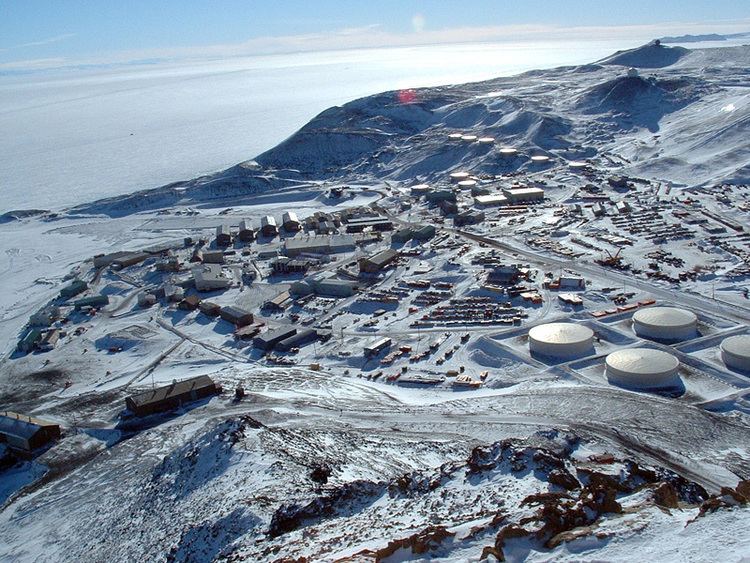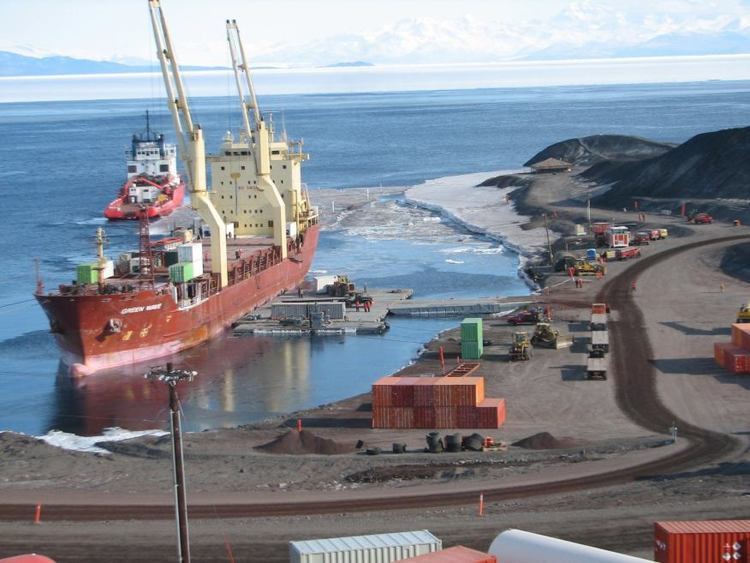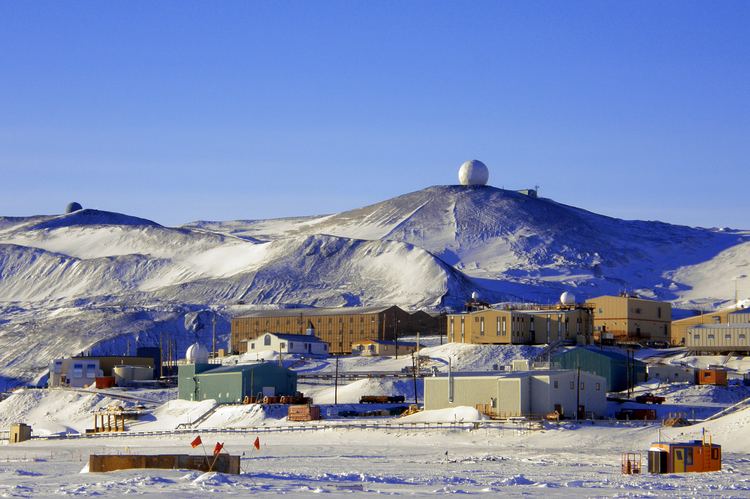Country United States Type All year-round | Time zone NZST (UTC+12) Area 250 ha | |
 | ||
Established 16 February 1956 (1956-02-16) | ||
Mcmurdo station antarctica a typical day
The McMurdo Station is a United States Antarctic research center on the south tip of Ross Island, which is in the New Zealand-claimed Ross Dependency on the shore of McMurdo Sound in Antarctica. It is operated by the United States through the United States Antarctic Program, a branch of the National Science Foundation. The station is the largest community in Antarctica, capable of supporting up to 1,258 residents, and serves as one of three United States Antarctic science facilities. All personnel and cargo going to or coming from Amundsen–Scott South Pole Station first pass through McMurdo.
Contents
- Mcmurdo station antarctica a typical day
- Driving from scott base to mcmurdo station
- History
- Nuclear power 19621972
- Contemporary functions
- Climate
- Communications
- Air
- Surface
- Historic sites
- Points of interest
- References

Driving from scott base to mcmurdo station
History

The station owes its designation to nearby McMurdo Sound, named after Lieutenant Archibald McMurdo of HMS Terror, which first charted the area in 1841 under the command of British explorer James Clark Ross. British explorer Robert Falcon Scott first established a base close to this spot in 1902 and built Discovery Hut, still standing adjacent to the harbour at Hut Point. The volcanic rock of the site is the southernmost bare ground accessible by ship in the Antarctic. The United States officially opened its first station at McMurdo on February 16, 1956. Founders initially called the station Naval Air Facility McMurdo. On November 28, 1957, Admiral George J. Dufek was present with a U.S. congressional delegation during a change of command ceremony.

McMurdo became the center of scientific and logistical operation during the International Geophysical Year, an international scientific effort that lasted from July 1, 1957, to December 31, 1958. The Antarctic Treaty, now signed by over forty-five governments, regulates intergovernmental relations with respect to Antarctica and governs the conduct of daily life at McMurdo for United States Antarctic Program (U.S.A.P.) participants. The Antarctic Treaty and related agreements, collectively called the Antarctic Treaty System (ATS), was opened for signature on December 1, 1959, and officially entered into force on June 23, 1961.

The first scientific diving protocols were established before 1960 and the first diving operations were documented in November 1961.

In 1974, Mary Alice McWhinnie and Sister Mary Odile Cahoon became the first women to winter-over at McMurdo Station.
Nuclear power 1962–1972
On March 3, 1962, operators activated a nuclear power plant at the station. The plant, like nearby Scott's Discovery Hut, was prefabricated in modules. Engineers designed the components to weigh no more than 30,000 pounds (14,000 kg) each and to measure no more than 8 feet 8 inches (2.64 m) by 8 feet 8 inches (2.64 m) by 30 feet (9.1 m). A single core no larger than an oil drum served as the heart of the nuclear reactor. These size and weight restrictions were intended to allow the reactor to be delivered in an LC-130 Hercules aircraft. However, the components were actually delivered by ship. The reactor generated 1.8 MW of electrical power and reportedly replaced the need for 1,500 US gallons (5,700 l) of oil daily. Engineers applied the reactor's power, for instance, in producing steam for the salt water distillation plant. As a result of continuing safety issues (hairline cracks in the reactor and water leaks), the U.S. Navy Nuclear Power Program decommissioned the plant in 1972. After the nuclear power station was no longer operational, conventional diesel generators were used. There were a number of 500 kilowatts (670 hp) diesel generators in a central powerhouse providing electric power. A conventionally fueled water desalination plant provided fresh water.
Contemporary functions
Today, McMurdo Station is Antarctica's largest community and a functional, modern-day science station, which includes a harbor, three airfields (two seasonal), a heliport and more than 100 buildings, including the Albert P. Crary Science and Engineering Center. The station is also home to the continent's two ATMs, both provided by Wells Fargo Bank. The primary focus of the work done at McMurdo Station is science, but most of the residents (approximately 1,000 in the summer and around 250 in the winter) are not scientists, but station personnel who are there to provide support for operations, logistics, information technology, construction, and maintenance.
Scientists and other personnel at McMurdo are participants in the USAP, which co-ordinates research and operational support in the region. Werner Herzog's 2007 documentary Encounters at the End of the World reports on the life and culture of McMurdo Station from the point of view of residents. And Anthony Powell's 2013 documentary Antarctica: A Year on Ice provides time-lapse photography of Antarctica intertwined with personal accounts from residents of McMurdo Station and adjacent Scott Base over the course of a year.
An annual sealift by cargo ships as part of Operation Deep Freeze delivers 8 million U.S. gallons (6.6 million imperial gallons/42 million liters) of fuel and 11 million pounds (5 million kg) of supplies and equipment for McMurdo residents. The ships are operated by the U.S. Military Sealift Command but are manned by civilian mariners. Cargo may range from mail, construction materials, trucks, tractors, dry and frozen food, to scientific instruments. U.S. Coast Guard icebreakers break a ship channel through ice-clogged McMurdo Sound in order for supply ships to reach Winter Quarters Bay at McMurdo. Additional supplies and personnel are flown in to nearby Williams Field from Christchurch, New Zealand.
Between 1962 and 1963, 28 Arcas sounding rockets were launched from McMurdo Station.
McMurdo Station is about two miles (3 km) from Scott Base, the New Zealand science station, and the entire island is within a sector claimed by New Zealand. Recently there has been criticism leveled at the base regarding its construction projects, particularly the McMurdo-(Amundsen-Scott) South Pole highway.
McMurdo has attempted to improve environmental management and waste removal over the past decade in order to adhere to the Protocol on Environmental Protection to the Antarctic Treaty, which was signed October 4, 1991, and entered into force January 14, 1998. This agreement prevents development and provides for the protection of the Antarctic environment through five specific annexes on marine pollution, fauna and flora, environmental impact assessments, waste management, and protected areas. It prohibits all activities relating to mineral resources except scientific. A new waste treatment facility, which greatly exceeds the requirements of the treaty, was built at McMurdo in 2003. Three Enercon E-33 (330 kW each) wind turbines were deployed in 2009 to power McMurdo and New Zealand's Scott Base, reducing diesel consumption by 11% or 463,000 litres per year. McMurdo (nicknamed "Mac-Town" by its residents) continues to operate as the hub for American activities on the Antarctic continent.
McMurdo Station briefly gained global notice when an anti-war protest was held on February 15, 2003. During the rally, about 50 scientists and station personnel gathered to protest the coming invasion of Iraq by the United States. McMurdo Station was the only Antarctic location to hold such a rally.
Scientific diving operations continue with 10,859 dives having been conducted under the ice from 1989 to 2006. A hyperbaric chamber is available for support of polar diving operations.
Climate
With all months having an average temperature below freezing, McMurdo features a polar ice cap climate (Köppen EF). However, in the warmest months (December and January) the temperature may occasionally be above freezing. The place is protected from cold waves from the interior of Antarctica by the Transantarctic Mountains, so temperatures below −40° are rare, compared to more exposed places like Neumayer Station, which usually gets those temperatures a few times every year, often as early as May, and sometimes even as early as April, and very rarely above 0 °C. The highest temperature ever recorded at McMurdo was 10.5 °C (50.9 Fahrenheit) on December 30, 2001.
Communications
For a time, McMurdo had Antarctica's only television station, AFAN-TV, running vintage programs provided by the military. The station's equipment was susceptible to "electronic burping" from the diesel generators that provide electricity in the outpost. The station was profiled in a 1974 article in TV Guide magazine. Now, McMurdo receives three channels of the US Military's American Forces Network, the Australia Network, and New Zealand news broadcasts. Television broadcasts are received by satellite at Black Island, and transmitted 25 miles (40 km) by digital microwave to McMurdo.
McMurdo Station receives both Internet and voice communications by satellite communications via the Optus D1 satellite and relayed to Sydney, Australia. A satellite dish at Black Island provides 20 Mbit/s Internet connectivity and voice communications. Voice communications are tied into the United States Antarctic Program headquarters in Centennial, Colorado, providing inbound and outbound calls to McMurdo from the US. Voice communications within station are conducted via VHF radio.
Air
McMurdo is serviced seasonally by three airports:
Surface
McMurdo has the world's most southerly harbor. A multitude of on- and off-road vehicles transport people and cargo around the station area, including Ivan the Terra Bus. There is a road from McMurdo to the South Pole, the South Pole Traverse.
Historic sites
Byrd Monument: The Richard E. Byrd Historic Monument was erected at McMurdo in 1965. It comprises a bronze bust on black marble, 150 cm (5 ft) x 60 cm (2 ft) square, on a wooden platform, bearing inscriptions describing the polar exploration achievements of Richard E. Byrd. It has been designated a Historic Site or Monument (HSM 54), following a proposal by the United States to the Antarctic Treaty Consultative Meeting.
Nuclear Power Plant Plaque: The bronze plaque is about 45 cm × 60 cm (18 in × 24 in) in size, and is secured to a large vertical rock halfway up the west side of Observation Hill, at the former site of the PM-3A nuclear power reactor at McMurdo Station. The inscription details the achievements of Antarctica’s first nuclear power plant. It has been designated a Historic Site or Monument (HSM 85), following a proposal by the United States to the Antarctic Treaty Consultative Meeting.
Points of interest
Facilities worthy of note at the station include:
